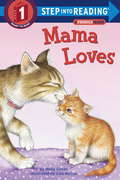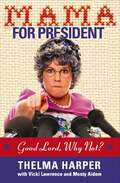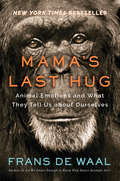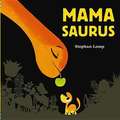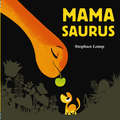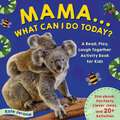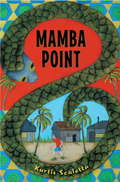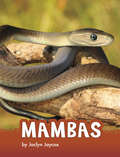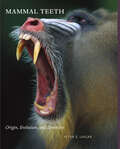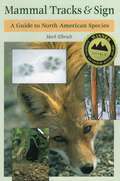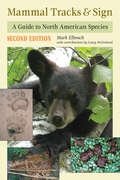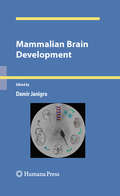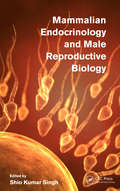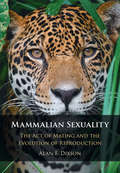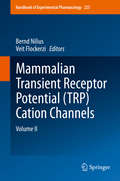- Table View
- List View
Mama Loves (Step into Reading)
by Lisa Mccue Molly Goode"Mama loves you, little kit,and lifts you gently by the scruff.Mama loves her pack of cubsand scolds you when you play too rough."Celebrate the love between mother and child in this gentle, rhymed rhapsody of mother-love as dogs, cats, bears, ducklings, whales -- and so many more -- shower unconditional love on their babies. Filled with best-selling illustrator Lisa McCue's menagerie of cuddly creatures, Mama Loves is perfect for human mamas to share with their young.
Mama for President: Good Lord, Why Not?
by Vicki Lawrence Monty AidemListen Up, America! The solution to your problems has plopped right in your lap. Mama is running for president! Discover How President Thelma Harper would handle: Immigration—I’ll tell you how we solve the problem at our border: build senior citizen housing all along the American side. No one sees more than a nosy old lady peeking through her window blinds. Emergency Preparedness—Emergency response should be in the hands of the experts who have the resources and determination to respond quickly. I’m talking about Domino’s and Pizza Hut. Airport Security—As long as we have to take our shoes off, I will install a shoe-buffing brush inside the X-ray machine so your shoes will get a little shine as they go through. Animals—If I have a dog at the White House, I will have it spayed or neutered to control its sex drive, which is something that might have been a good idea for some of our previous presidents. Thelma Harper is running for president, and the free world will never be the same!
Mama's Day with Little Gray
by Aimee ReidFrom talented illustrator Laura Bryant and gifted newcomer Aimee Reid comes a charming, heartwarming story about a little elephant's love for his mama."Mama, when I grow up, will you grow down?" What would it be like if, one day, Little Gray were the big elephant and Mama the small one? Little Gray can picture it perfectly. He'd shade her from the sun, teach her to make mud, and find pictures in the clouds with her. In fact, he would do for her exactly what she does for him.
Mama's Kisses
by Kate McMullanFrom bestselling author Kate McMullan, a sweet rhyming bedtime story celebrating mothers&’ love It's bedtime in the jungle, but baby panda, elephant, orangutan, and leopard are nowhere to be found. Their mamas set out to look for their wayward little ones, calling them to bed with a soft lullaby. But look! The baby animals are crawling, creeping, hiding, and giggling, playfully staying just one step ahead of their loving mamas. Kate McMullan's lilting rhymes pair perfectly with Tao Nyeu's rich illustrations, creating a dreamy picture book that is a perfect new baby or mother&’s day gift.
Mama's Last Hug: Animal Emotions And What They Tell Us About Ourselves
by Frans De WaalNew York Times best-selling author and primatologist Frans de Waal explores the fascinating world of animal and human emotions. <P><P> Frans de Waal has spent four decades at the forefront of animal research. Following up on the best-selling Are We Smart Enough to Know How Smart Animals Are?, which investigated animal intelligence, Mama’s Last Hug delivers a fascinating exploration of the rich emotional lives of animals. <P><P> Mama’s Last Hug begins with the death of Mama, a chimpanzee matriarch who formed a deep bond with biologist Jan van Hooff. When Mama was dying, van Hooff took the unusual step of visiting her in her night cage for a last hug. Their goodbyes were filmed and went viral. Millions of people were deeply moved by the way Mama embraced the professor, welcoming him with a big smile while reassuring him by patting his neck, in a gesture often considered typically human but that is in fact common to all primates. This story and others like it form the core of de Waal’s argument, showing that humans are not the only species with the capacity for love, hate, fear, shame, guilt, joy, disgust, and empathy. <P><P> De Waal discusses facial expressions, the emotions behind human politics, the illusion of free will, animal sentience, and, of course, Mama’s life and death. The message is one of continuity between us and other species, such as the radical proposal that emotions are like organs: we don’t have a single organ that other animals don’t have, and the same is true for our emotions. Mama’s Last Hug opens our hearts and minds to the many ways in which humans and other animals are connected, transforming how we view the living world around us. <P><b>A New York Times Bestseller</b>
Mama, Why?
by Karma WilsonAges 3-7. The day is done. Night is nigh. And Polar Cub asks, "Mama, why?" The moon is high. The stars are bright. And Polar Cub asks, "Mama, why?" It's time for sleep. It's time for dreams. And Polar Cub asks, "Mama, why?" Share in this glowing, timeless lullaby from beloved, bestselling author Karma Wilson and award-winning illustrator Simon Mendez Picture descriptions present.
Mama, Will I Be Yours Forever?
by Anna PignataroThe precious follow-up to MAMA WILL YOU HOLD MY HAND? and MAMA, HOW LONG WILL YOU LOVE ME? From bestselling author/illustrator Anna Pignataro comes the third title in her bestselling series, MAMA, WILL I BE YOURS FOREVER?, a sweet and loving portrayal of what "forever" means. The world is a very big place filled with everyday wonders that can both fascinate and confuse young readers. But Anna's text and sweeping illustrations are reassuring and engaging, showcasing the love of a parent for their child as well as introducing children to the many wonders of nature and life.
Mamasaurus
by Stephan LompThis colorful and reassuring picture book follows Babysaurus on an adventure as he enlists his prehistoric friends to seek his Mamasaurus. Is his Mamasaurus the fastest in the jungle? No. Is she the loudest? No. Is she the best flyer? No! Of course, Mamasaurus has been right there all along. And when Babysaurus needs a little help, she is ready with a big hug and a sweet, leafy snack. For Babysaurus, his Mamasaurus is the best mamasaurus in the world! Stephan Lomp has illustrated several books in his native Germany, and in this debut as both author and artist, he has created a fresh twist on a perennial theme that will win the hearts of little ones and their mamas as they snuggle up to read a new favorite.
Mamasaurus
by Stephan LompThis colorful and reassuring picture book follows Babysaurus on an adventure as he enlists his prehistoric friends to seek his Mamasaurus. Is his Mamasaurus the fastest in the jungle? No. Is she the loudest? No. Is she the best flyer? No! Of course, Mamasaurus has been right there all along. And when Babysaurus needs a little help, she is ready with a big hug and a sweet, leafy snack. For Babysaurus, his Mamasaurus is the best mamasaurus in the world! Stephan Lomp has illustrated several books in his native Germany, and in this debut as both author and artist, he has created a fresh twist on a perennial theme that will win the hearts of little ones and their mamas as they snuggle up to read a new favorite.Plus, this is the fixed-format version, which looks almost identical to the print edition!
Mama… What Can I Do Today?: A Read, Play, Laugh Together Activity Book for Kids
by Kate JeromeFilled with silly animal jokes, games, puzzles, mazes and more, Mama... What Can I Do Today? combines an adorable rhyming storybook with more than 20 animal-inspired activities. Mama... What Can I Do Today? uses kids&’ natural fascination with animals to develop essential literacy, academic and social-emotional skills while keeping them busy and engaged. Vibrant full-color photography of more than 40 furry, scaly and feathered friends brings the animal kingdom to life! READ AND DO: The first part of Mama... What Can I Do Today? is a 28-page rhyming storybook that answers the perennial question with an action inspired by an animal, and a vibrant photograph of an animal, such as &“climb a tree&” like a koala in a eucalyptus, or &“jump for joy&” like dolphins leaping from the water. MAKE, LAUGH AND PLAY: The second part of Mama... What Can I Do Today? includes more than 20 fun, engaging activities! Animal jokes, facts, drawing activities, story prompts, mazes and more extend the animal-themed fun! PERFECT FOR PRE AND EARLY STAGE READERS: Pre-readers can read the story and do the activities together with their grown-ups, and emergent readers will gain independence and confidence reading and doing activities on their own. DEVELOP ESSENTIAL SKILLS: Reading aloud improves language and listening skills and strengthens social emotional development and bonding with parents. EXPLORE THE ANIMAL WORLD: Filled with full-color photos and dozens of facts about more than 40 animals from every animal kingdom: jungles, forests, farms, oceans, rivers and backyards. EXPERT AUTHOR: Award-winning author and former teacher Kate Jerome&’s expertise in intergenerational communication opens a dialogue between grown-up and child in a clever and engaging way.
Mamba Point
by Kurtis ScalettaWhen his dad gets a job at the U. S. embassy in Liberia, twelve-year-old Linus Tuttle knows it's his chance for a fresh start. Instead of being his typical anxious self, from now on he'll be cooler and bolder: the new Linus. But as soon as his family gets off the plane, they see a black mamba--one of the deadliest snakes in Africa. Linus's parents insist mambas are rare, but the neighborhood is called Mamba Point, and Linus can barely go outside without tripping over one--he's sure the venomous serpents are drawn to him. Then he hears about kasengs, and the belief that some people have a deep, mysterious connection to certain animals. Unless Linus wants to hide in his apartment forever (drawing or playing games with the strange kid downstairs while his older brother meets girls and hangs out at the pool), he has to get over his fear of his kaseng animal. Soon he's not only keeping a black mamba in his laundry hamper; he's also feeling braver than ever before. Is it his resolution to become the new Linus, or does his sudden confidence have something to do with his scaly new friend? From Kurtis Scaletta, author ofMudville, comes a humorous and compelling story of a boy learning about himself through unexpected friends, a fascinating place, and an extraordinary animal.
Mamba Point
by Kurtis ScalettaAfter moving with his family to Liberia, twelve-year-old Linus discovers that he has a mystical connection with the black mamba, one of the deadliest snakes in Africa, which he is told will give him some of the snake's characteristics. Includes note by the author about his experiences as a thirteen-year-old American living in Liberia in 1982.
Mambas (Animals)
by Jaclyn JaycoxMambas can be either green or black. These dangerous snakes kill prey with their venomous bite. Then they swallow their prey whole! Learn more about these awesome snakes.
Mammal Mania: 30 Activities and Observations for Exploring the World of Mammals (Young Naturalists)
by Lisa J. AmstutzHow big is a blue whale? Why does a sloth crawl from the safety of a tree to the ground once a week? How does a vampire bat feed? Young nature enthusiasts will find answers to these questions and learn all sorts of fascinating facts about mammals in this full-color, interactive book. Mammal Mania explores what makes mammals unique, as well as their anatomy, behavior, and conservation needs. Thirty hands-on activities promote observation and analysis, writing and drawing, math and science, and nature literacy skills. Readers will learn to build a squirrel feeder, write a putrid poem, make an animal tracking station, and much more. This useful resource includes a glossary of scientific terms, a list of mammal orders, and a teacher's guide to initiate classroom discussion.
Mammal Societies
by Tim Clutton-BrockThe book aims to integrate our understanding of mammalian societies into a novel synthesis that is relevant to behavioural ecologists, ecologists, and anthropologists. It adopts a coherent structure that deals initially with the characteristics and strategies of females, before covering those of males, cooperative societies and hominid societies. It reviews our current understanding both of the structure of societies and of the strategies of individuals; it combines coverage of relevant areas of theory with coverage of interspecific comparisons, intraspecific comparisons and experiments; it explores both evolutionary causes of different traits and their ecological consequences; and it integrates research on different groups of mammals with research on primates and humans and attempts to put research on human societies into a broader perspective.
Mammal Teeth: Origin, Evolution, and Diversity
by Peter S. UngarWinner, 2010 PROSE Award for Excellence in the Biological Sciences. Professional and Scholarly Publishing division of the Association of American PublishersIn this unique book, Peter S. Ungar tells the story of mammalian teeth from their origin through their evolution to their current diversity.Mammal Teeth traces the evolutionary history of teeth, beginning with the very first mineralized vertebrate structures half a billion years ago. Ungar describes how the simple conical tooth of early vertebrates became the molars, incisors, and other forms we see in mammals today. Evolutionary adaptations changed pointy teeth into flatter ones, with specialized shapes designed to complement the corresponding jaw. Ungar explains tooth structure and function in the context of nutritional needs. The myriad tooth shapes produced by evolution offer different solutions to the fundamental problem of how to squeeze as many nutrients as possible out of foods. The book also highlights Ungar's own path-breaking studies that show how microwear analysis can help us understand ancient diets.The final part of the book provides an in-depth examination of mammalian teeth today, surveying all orders in the class, family by family. Ungar describes some of the more bizarre teeth, such as tusks, and the mammal diversity that accompanies these morphological wonders. Mammal Teeth captures the evolution of mammals, including humans, through the prism of dental change. Synthesizing decades of research, Ungar reveals the interconnections among mammal diet, dentition, and evolution. His book is a must-read for paleontologists, mammalogists, and anthropologists.
Mammal Tracks & Sign
by Mark ElbrochDetailed track and trail data for 135 species with actual-size track illustrations.
Mammal Tracks & Sign: A Guide to North American Species
by Mark Elbroch Casey McFarlandThe most comprehensive reference guide to mammal tracks and sign for North America. This new edition is more visual, with more than 1300 photos and 450 illustrations for easy comparison and identification of similar sign. Each species account includes information on tracks and trails, scat and urine, nests and lodges, as well as sign on the ground, in trees and shrubs, on fungi and on plants. Winner of the 2019 National Outdoor Book Award for Outdoor Classic Books.
Mammalian Brain Development
by Damir JanigroThis book fills a gap in developmental books dealing with the normal prenatal mammalian brain. Most books that approach this topic work with non-human, non-vertebrate models. Mammalian Brain Development focuses on both the pre-natal and the peri-natal events that lead to brain damage as seen in the prospective of medical and research professionals, as well as examining the traditional "nature versus nurture" argument in the spectrum of brain development. The major topics addressed, in detail, in the book are sexual dimorphism, epigenetic action of gonadal hormones, environmental "programming" effects, autism, developmental learning disorders, seizures, and the etiopathogenesis of epileptic syndromes in young humans. The book also covers the general aspects of postnatal and pediatric neurological disorders in a unique and novel way by offering definitions of heredity, inheritance, genetic-epigenetic, genomic, molecular, developmental, and innate aspects of the mammalian brain in regards to its development.
Mammalian Egg Transfer
by Lewis AdamsEgg transfer was first performed in 1890, but for half a century it received scant attention. However, since 1950 the technique has become increasingly widely used - in the laboratory for fundamental studies and more recently in practice, both veterinary and medical, to boost reproductive potential of genetically superior cattle and to overcome sterility due to impaired rubal function in women. As a result, a considerable body of literature has accumulated, totaling well in excess of a thousand references. But till now there has not been a single comprehensive text devoted solely to this subject. The present work was designed to meet that need at a time when the field is fast expanding with new techniques and approaches constantly being evolved. One need only cite the tremendous rate of progress in human egg transfer in the last three years. The work embraces laboratory and farm animals and primates, including man, altogether representing a total of 16 species.
Mammalian Endocrinology and Male Reproductive Biology
by Shio Kumar SinghMammalian Endocrinology and Male Reproductive Biology provides comprehensive and current coverage of the area of endocrinology and male reproductive biology, covering not just humans, but mammals in general. Written by international experts in their respective fields, this multi-author book also covers the latest developments in genomics of androge
Mammalian Neuroendocrinology
by Paul V. MalvenMammalian Neuroendocrinology presents a concise examination of how the nervous and endocrine systems interact to regulate physiological processes. Selected experimental results are presented to illustrate the current understanding of neuroendocrine processes. Neural influences and endocrine feedback mechanisms related to the secretion of adenohypophysial hormones are summarized for each hormone. The book's concise nature and readable style are highly suited for use as a graduate textbook.There are also chapters devoted to each of the following topics: neurohypophysis, pineal gland, adrenal medulla, hormones and behavior, and neuroendocrine immunology. Comparisons are made among species of mammals, including laboratory rodents, domesticated ungulates, and primates. Agricultural and/or clinical aspects relevant to these topics are covered when appropriate. Mammalian Neuroendocrinology is excellent for students and professionals in neuroendocrinology, neuroscience, endocrinology, reproduction studies, and animal sciences.
Mammalian Paleoecology: Using the Past to Study the Present
by Felisa A. SmithWhat can the interactions of ancient mammals and their environments tell us about the present—and the future?Classic paleontology has focused on the study of fossils and the reconstruction of lineages of extinct species. But as diverse fossils of animals and plants were unearthed and catalogued, it became possible to reconstruct more elaborate ecosystems, tying together plants, animals, and geology. By the second half of the twentieth century, this effort gave birth to the field of paleoecology: the study of the interactions between organisms and their environments across geologic timescales. In Mammalian Paleoecology, Felisa Smith broadly considers extinct mammals in an ecological context. Arguing that the past has much to teach us and that mammals, which display an impressive array of diverse life history and ecological characteristics, are the ideal organism through which to view the fossil record, Smith• reviews the history, major fossil-hunting figures, and fundamental principles of paleoecology, including stratigraphy, dating, and taphonomy• discusses the importance of mammal body size, how to estimate size, and what size and shape reveal about long-dead organisms• explains the structure, function, and utility of different types of mammal teeth• highlights other important methods and proxies used in modern paleoecology, including stable isotopes, ancient DNA, and paleomidden analyses• assesses nontraditional fossils• presents readers with several case studies that describe how the fossil record can help inform the scientific discussion on anthropogenic climate changeMammalian Paleoecology is an approachable overview of how we obtain information from fossils and what this information can tell us about the environments of the distant past. It will profoundly affect the way paleontologists and climatologists view the lives of ancient mammals.
Mammalian Sexuality: The Act of Mating and the Evolution of Reproduction
by Alan F. DixsonThere are more than 6000 species belonging to twenty-seven orders in the Class Mammalia. Comparative studies of this diverse and magnificent array of extant species provide valuable opportunities to formulate and test hypotheses concerning the evolution of reproduction. This is the first book to explore, in depth and breadth, the complex interrelationships that exist between patterns of mating behaviour and the evolution of mammalian reproductive anatomy and physiology. It focuses upon the role that copulatory and post-copulatory sexual selection have played during the evolution of the monotremes, marsupials and placental mammals, and examines the effects of sperm competition and cryptic female choice upon coevolution of the genitalia in the two sexes. In addition, due weight is also given to discussions of the modes of life of mammals, and to the roles played by natural selection and phylogeny in determining their reproductive traits.
Mammalian Transient Receptor Potential (TRP) Cation Channels
by Bernd Nilius Veit FlockerziIn this fast moving field the main goal of this volume is to provide up-to-date information on the molecular and functional properties and pharmacology of mammalian TRP channels. Leading experts in the field will describe properties of a single TRP protein/channel or portray more general principles of TRP function and important pathological situations linked to mutations of TRP genes or their altered expression. Thereby this volume on Transient Receptor Potential (TRP) Channels provides valuable information for readers with different expectations and backgrounds, for those who are approaching this field of research as well as for those wanting to make a trip to TRPs.
